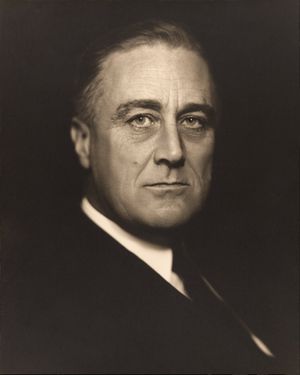When was the controversial Export-Import Bank Created
When President Franklin Delano Roosevelt took office in March 1933, he immediately focused his attention on the domestic economic situation created by the Great Depression. Believing that recovery would come from measures taken at home rather than abroad, he secured Congressional passage of a series of far-reaching domestic economic reforms that would come to be known as the first New Deal.
FDR sought to lessen the effects of Depression with reduction in trade barriers
His doubts about the ability of foreign economic policy to contribute to domestic recovery were reflected in his approach to the London Economic Conference. In June 1933, representatives from 66 countries gathered in London to try to find a way out of the Depression through cooperation in areas such as the reduction of trade barriers and the stabilization of exchange rates.
Countries that remained on the gold standard, such as France, sought to convince countries that had left the gold standard, particularly the United Kingdom (in September 1931) and the United States (in April 1933), to agree to stabilize the par values of their currencies. The chances for success were already slim when, on July 3, Roosevelt rejected such an agreement as “a purely artificial and temporary experiment,” asserting that a “sound internal economic situation” was more important to a country’s prosperity than the external value of its currency. The conference ended less than a month later with little to show for its efforts.
Why was the Export-Import Bank created?
In 1934, the Roosevelt Administration undertook two initiatives that signaled a desire to re-engage economically with the rest of the world. The first was the creation of the Export-Import Bank. In February 1934, Roosevelt established the bank as an institution designed to finance U.S. trade with the newly-recognized Soviet Union. He created a second Export-Import Bank the following month, this one intended to finance trade with Cuba; in July 1934, the second bank’s field of operations was expanded to include all countries save the Soviet Union.
In 1935, the two banks were combined and Congress passed legislation granting the newly unified bank more powers and more capital. In the years before the start of the Second World War, while it did extend credits to countries outside the Western Hemisphere such as Italy and China, the Export-Import Bank concentrated its efforts in Latin America, where it proved an important component of the Good Neighbor policy.
The second major foreign economic policy initiative of 1934 was the Reciprocal Trade Agreements Act (RTAA). In March 1934, proclaiming “that a full and permanent domestic recovery depends in part upon a revived and strengthened international trade,” Roosevelt asked Congress for authority to negotiate trade agreements based upon reciprocal tariff reductions with other countries. Signed into law on June 12, 1934, the RTAA represented a fundamental shift in U.S. trade policy. The Constitution gives Congress the right to regulate foreign commerce and establish tariff rates.
Under the RTAA, Congress granted the president the right – on a temporary basis, subject to renewal after three years – to decrease or increase U.S. tariffs by up to 50% of the levels set by the 1930 Smoot-Hawley tariff in exchange for tariff concessions by other countries. Such tariff reductions would be brought into force through executive agreements, rather than treaties requiring Senate approval. U.S. tariff cuts negotiated under the RTAA would also be extended to all third countries to which the United States had accorded most favored nation status.
Reciprocal Trade Agreements Act led to GATT
Between 1934 and 1939, the Roosevelt Administration concluded trade agreements with 19 countries under the Reciprocal Trade Agreements Act: Belgium, Brazil, Canada, Colombia, Costa Rica, Cuba, Czechoslovakia, Ecuador, El Salvador, Finland, France, Guatemala, Haiti, Honduras, the Netherlands, Nicaragua, Sweden, Switzerland, and the United Kingdom. After 1945, the tariff negotiating procedure established under the RTAA program provided the model for that of the General Agreement on Tariffs and Trade (GATT), the agreement signed by 23 countries in 1947 that has provided the framework for multilateral trade liberalization in the post-WWII era.
